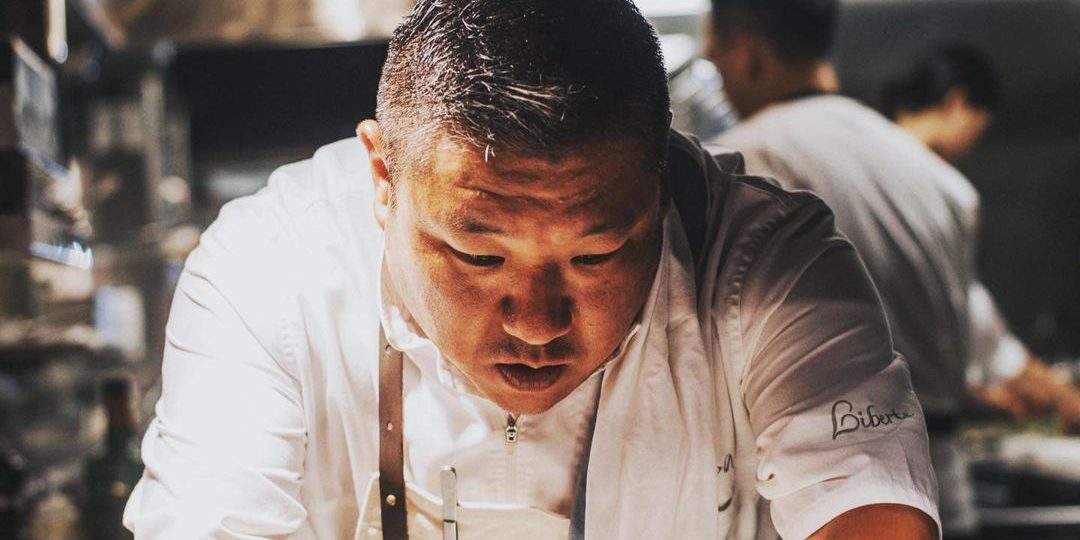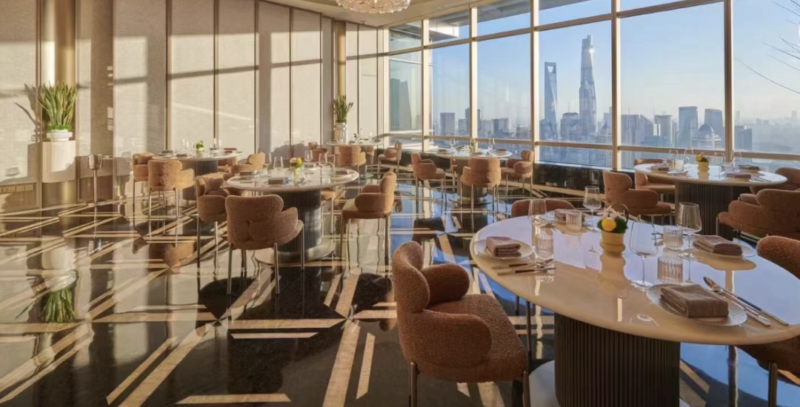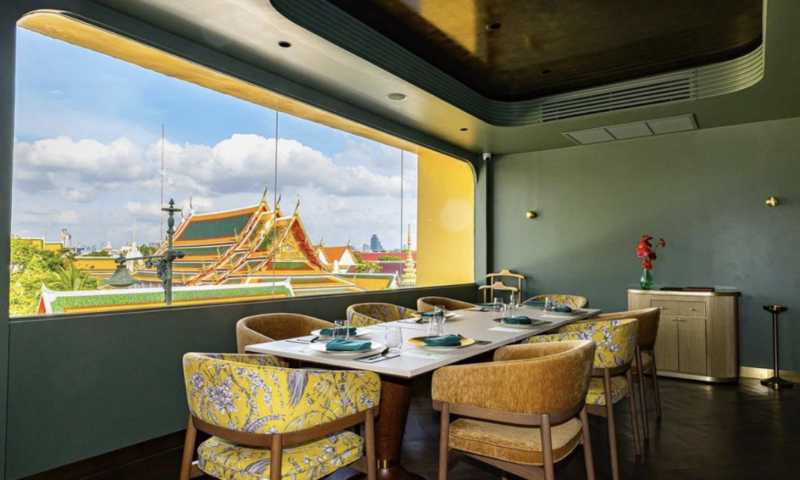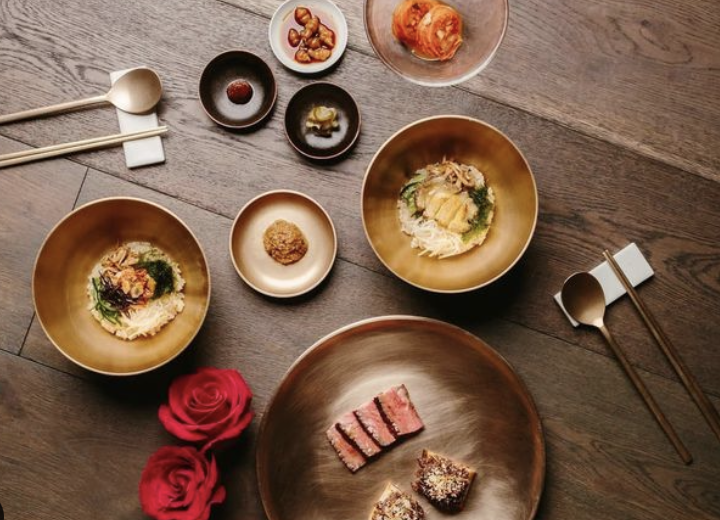Author: Jocelyn Chen

Photo Taken by Peray
Chef Kenji Takeda was soon awarded a Michelin star the year after his stunningly delicious restaurant Liberté a Table de TAKEDA was opened in Tokyo in 2012. Michelin is a double-sided honour that comes with shackles. Granted with one star for five years, Takeda decided to close down the restaurant and subsequently missed out on two stars. Prompted by the initiative to seek development overseas, Takeda eventually made his presence in the city of Kaohsiung in Taiwan, where his new restaurant has been flocked with diners since its opening at the start of this year.
2017 · Tokyo
Takeda’s restaurant in Tokyo was tucked in an independent villa in a quiet alleyway of Azabu-juban. Apart from offering exquisite Japanese-inspired cuisines, the French-style restaurant on the ground floor also had a secluded water garden with streams flowing peacefully down stone bridges.
French chefs rarely use puffer fish as main course, but Liberté does. Its selection of sake as a pairing drink is quite innovative as well. Takeda’s cuisine features delicate style and sophisticated techniques, but is generally light-handed to the whole structure.


Chef Takeda and the Author (2017 Tokyo)
The decision to close down his restaurant in Tokyo was perhaps the result of a saddened ambition. Surviving a city that’s saturated with over 150 Michelin one-stars was not something easy to accomplish. I remember Takeda told me then that he wanted an open kitchen, ideally in a foreign country. Many local chefs were envious of Florilege’s open kitchen design, which, to Takeda’s surprise, came to the realization in his Kaosiung restaurant.
2021 · Kaohsiung

I am pleased to see Liberté’s landing in Kaohsiung. Takeda’s dishes convey a high level of complexity, yet each ingredient compliments each other, decking out a scrumptious array of flavours. Designed with a smooth consistency and creative twists, most dishes on the menu deserve all the WOWs and possibly more.


Dishes
I was impressed by most of the dishes at Liberté Kaohsiung that day.
The first dish, Flan de Foie Gras, had a texture somewhere between steamed egg custard and cream mousse. It’s flavoured with chicken stock and steamed over a warm fire. Topped off with a special sauce made from aged Shaoxing yellow wine and truffles, the dish was served with fried buckwheat and Chinese chestnuts to add texture and aroma. The warm and refreshing sensation reminded me that many classic bars in Tokyo used to serve a small glass of French consommé to warm up customers before the drinking officially started. That evening at Liberté as I recall, had a gentle start like that as well.
Another starter, monkfish liver, was flavoured with salt, trehalose and vermouth. Absolutely not fishy and instantly melts in the mouth. The soup was pristine without a hint of incongruity.

Monkfish Liver

Tsubaki Fish
Takeda prepared an impromptu white asparagus dish for us at the meal. The crunchy white asparagus tips were first boiled in brine and chilled in ice to preserve the crisp texture and upgrade sweetness. He specifically mentioned taking thin slices from the middle of the asparagus to avoid undesired flavours. Fresh prawns from Northeast Taiwan were seasoned with lemon, French chilli powder and olive oil, then added with caviar to jazz up the umami flavour. Chef Takeda’s favourite part was adding kombu soy sauce and a bracing cool soup made from white asparagus and milk, leaving you lingering flavours with rich texture and refreshing experience that preludes a whiff of the coming summer. It is the first and easily the best white asparagus dish I’ve eaten this year, and I’m glad the white asparagus was from my hometown Yunlin.

White Asparagus Dish
Shirako was first boiled in sake and vegetable broth, then cooled in a puffer fish stock before being steamed and slightly grilled until crisp on the outside. Served alongside with fresh, tangy cod roe dusted with mushroom sauce, this dish was simply wonderful!
We were served seabass with a sauce béchamel mixed with chopped fermented mustard greens and fine shallots – well, a Chinese-French fusion rendering.
Why Buddha Jumps Over the Wall
I was impressed by the dish Buddha Jumps Over the Wall (Chinese: 佛跳墙; a variety of shark fin soup in Fujian cuisine) with Puffy Pastry. Probably considered the most opulent and luxurious dish in the entire Chinese canon, Takeda’s Taiwanese-inspired version of the recipe includes the usual likes of duck liver, chestnuts, abalone and Jinhua ham, yet interestingly paired with French consommé. Takeda kindly cut open the top of the crumbling pastry for us and grated winter black truffle slices into the consommé to add a hint of French luxury.


Buddha Jumps Over the Wall
The aged hen and fresh vegetables were precooked for two days. Unlike a typical French consommé, the soup base is made clear by perfect temperature control emphasizing the process instead of using minced meat and eggs, thus preserving a unique pristine flavour. Jinhua ham and dried scallops were then added to let simmer overnight.
The consommé was naturally umami and melting, with fish maws, bamboo shoots, duck liver and abalone each shining in their own way. A sip of it was enough to melt my heart into warm puddles and bring back the carefree childhood memories. Takeda sometimes uses dried abalone mainly sourced from Northeast Taiwan.
The puff crust was beautifully done, crisp but not too flaky, buttery but not too greasy. A more tantalizing rendition of the traditional Buddha Jumps Over the Wall that won’t sit heavy in your stomach.
The Ling Long Restaurant in Beijing has a similar way of doing the dish, but probably by different cooking methods based on how they look. I guess great minds think alike.
Solid skills and intricate dishes have been Takeda’s representative strengths. But what really puts him ahead is that he knows how to bring out the best of all ingredients without compromising their distinct flavours. Either his taste buds are keen and more sensitive, or he has been given more freedom for creativity since coming to Taiwan.
Liberté handles its pigeon dish with utter cleverness. Pigeon is from Pingtung county in Southern Taiwan, wrapped in bamboo charcoal mixed dough, soaked in brine, and air-dried for a few days. It’s then simmered at low heat, fast froze before wrapped up in bamboo charcoal flour and deep-fried. This cooking method Takeda comes up with is derived from American hot dogs in Japan.
It is deep-fried again and then flame-grilled before serving. The dish straddles the line between sweet and savoury with the crispy pigeon skin and the slightly salty meat which took its relish from the gravy. The morel mushroom sauce adds complexity to the whole flavour box.

Pingtung Pigeon
Takeda’s dishes are extremely well presented, and what appears to be a simple dish is handled in a way that is beyond our imagination. I personally love cooking, but his dishes are not easy to tell how they are actually done. They are delicate, complex and highly artistic, yet not deviating from his cooking principles. If Michelin comes to Kaohsiung in the future, Liberté is at least a two-star.
The final dish, strawberry and white chocolate ice cream with Maqaw pepper, was bright and inventive. Frozen strawberries are common, but rapid freezing and slicing on site add to the visual effect.
The ice cream is topped with a layer of strawberry jam and an aboriginal spice from Taiwan–Maqaw pepper. The flavour of Maqaw, suggested by its name of ‘mountain pepper,’ is a well-balanced combination of peppery spice and fresh lemon. Dried frozen strawberries were sliced to create a crisp sound. A brilliant visual experience and an interesting ending.
Consistent and satisfying.

Tenderness of Chef Takeda
I’ve always found Mr. Takeda’s appearance bit like an underworld boss. He is straightforward, outspoken and can sometimes get sharp. But stereotypes are meant to be broken. He approaches the food with lyricism, romanticism, and an unwavering dedication to deliciousness, which is reflective of the kindness and tenderness of his true character.
The cultures of Tokyo and Kaohsiung are very different and Takeda is still getting used to the new city. When I asked what he thought about coming to Kaohsiung, Takeda said he was worried that customers only come for the restaurant’s fame, not for the food. But I reassured him that there is no need to be too concerned because a restaurant like Liberté would simply light up Kaohsiung.
The Journey to Southern Taiwan
Tokyo may not the place of luck for him, but as a Fine Dining chef, Takeda followed his fate and came to Taiwan. Thanks to this, he is able to play with contrasts and textures in ways both thoughtful and ingenious, free from the frames of convention and protocol. He sees himself in Liberté, and diners can enjoy dishes reflective of his true personality.
That Chef Takeda is likely to be the most skilled chef in Southern Taiwan is beyond question. He and Liberté have brought an oasis to the culinary desert of Kaohsiung. Together with the unveiling of SHO in Kaohsiung, a Japanese restaurant opened by a two-starred Michelin restaurant DEN from Tokyo ( ‘DEN SHO’ means to inherit in Japanese), and the newly opened Mathariri at AKAME in Pingtung, they are expected to turn Southern Taiwan into a new culinary magnet in the near future.
We all want to chase our dreams and live a wonderful life. There are millions of talented people in different walks of life, but talent does not always translate to success. Lucky ones become early achievers, and those who aren’t lucky enough may become late bloomers. Takeda is the latter. After all, life is about waiting for the right moment to react. Despite of some detours, Fortuna has finally found her way to Takeda’s side. Now I am ready to see him rise and shine.
Written by: Jocelyn Chen
Photos are provided by Peray
This article is published in United Daily News
Liberté
Address: No.802, Zhonghua 5th Road, Qianzhen District, Kaohsiung City, Taiwan
Reservation URL: www.liberte.com.tw/tw/reservation.html











